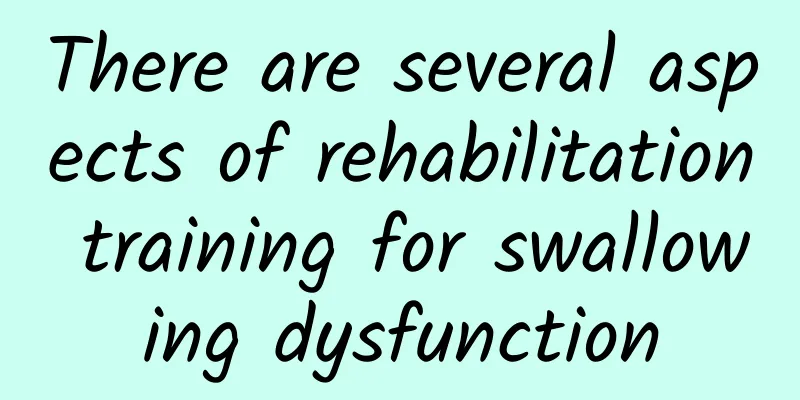There are several aspects of rehabilitation training for swallowing dysfunction

|
Swallowing dysfunction refers to the difficulty or abnormality of an individual in eating, which manifests as swallowing discomfort, coughing, dyspnea and other symptoms. This dysfunction not only affects the individual's quality of life, but in severe cases may even lead to complications such as malnutrition and lung infection. Therefore, timely diagnosis and rehabilitation training of swallowing dysfunction is crucial. Causes of swallowing dysfunction: There are many causes of swallowing dysfunction, including neurological diseases, musculoskeletal diseases, and drug side effects. Among them, the most common causes are neurological diseases, such as stroke and Parkinson's disease. These diseases can cause control disorders of the oral, throat, and esophageal muscles, thereby affecting the swallowing process. Assessment of swallowing dysfunction: Assessment of swallowing dysfunction is a key step in rehabilitation training. Assessment methods include clinical examination, swallowing angiography, fiber endoscopy, etc. Among them, swallowing angiography is the most commonly used assessment method, which can visually observe the swallowing process and discover potential swallowing problems. Rehabilitation training program for swallowing dysfunction: should be formulated according to individual conditions, including the following aspects: Oral muscle training: By strengthening the training of the oral muscles, you can improve oral control ability and prepare for subsequent swallowing training. Swallowing muscle training: Training different swallowing muscle groups, such as tongue muscles, pharyngeal muscles, etc., through specific movements and exercises to improve the contraction ability and coordination of the muscle groups. Sensory stimulation training: Through sensory stimulation such as touch and temperature, the individual's perception of food and water is improved, thereby improving the swallowing process. Adjusting eating posture: For some individuals, adjusting eating posture can improve swallowing. For example, eating in the side-lying position can reduce the risk of food entering the nasal cavity. Psychological support: Swallowing dysfunction may bring negative emotions to individuals, such as anxiety, depression, etc. Therefore, psychological support is equally important in rehabilitation training. The case analysis takes a 60-year-old stroke patient as an example. He had obvious swallowing dysfunction after the onset of the disease. After receiving rehabilitation training, he was first evaluated in detail and found that his tongue muscles and throat muscles had obvious contraction weakness. Therefore, a series of rehabilitation training plans were formulated, including strengthening training of oral muscles and swallowing muscles, sensory stimulation training, and adjustment of eating posture. During the training process, he was also given psychological support to help him build confidence. After one month of training, the patient's swallowing function was significantly improved and the problem of difficulty in eating was solved. Swallowing dysfunction is a common clinical problem that has a serious impact on the patient's quality of life and health status. Through detailed evaluation and the development of targeted rehabilitation training plans, the patient's swallowing function can be effectively improved. Rehabilitation training includes training of oral muscles and swallowing muscles, sensory stimulation training, adjustment of eating posture, and psychological support. When implementing rehabilitation training, the patient's specific situation should be fully considered and a personalized training plan should be developed. At the same time, doctors should pay attention to communication with patients and their families to ensure that they fully understand the importance and participation of rehabilitation training. Through the joint efforts of both doctors and patients, it is expected to achieve the greatest improvement in swallowing dysfunction. (Sun Hongyan, Medical Industry) |
<<: Fat is the invisible boss that maintains human health
Recommend
When is the safe period for women after menstruation
The female safe period allows couples or lovers w...
Is it normal to have a hot head? Unexpectedly, a healthy brain temperature can reach 40℃ everyday!
When people are excited, they do some irrational ...
The latest data shows that the number of Windows Phone Store apps has exceeded 130,000
On February 26, 2013, Microsoft announced at the ...
What kind of diseases will be caused by not taking good care of the confinement period?
Most women have to go through the process of preg...
What to do if breast nodules are irregular
The problem of irregular breast nodules is a big ...
What kind of lotus root is used for frying lotus root slices? Is it better to use flour lotus root or crispy lotus root for frying lotus root slices?
We all know that lotus root is a common food, and...
Don’t blame cold for knee pain! Research reveals coffee is an accomplice of knee arthritis
In our daily lives, the health of the knee joint ...
Treatment of pelvic inflammatory disease cannot be rushed
Ms. Wang, 40, is successful in her career and is ...
A woman has a little pain when she urinates
With the improvement of women's self-awarenes...
Can pregnant women use Anessa sunscreen?
Can pregnant women use Anessa sunscreen? Among th...
My breasts have swelled for 10 days but I haven't had my period yet.
Breast is a key part of the female body. With the...
Why do you need a colposcopy?
Colposcopy is a common gynecological examination ...
United Nations Diabetes Day | Diabetic patients should be alert to malnutrition
November 14th is United Nations Diabetes Day, and...
Many diseases can be traced back to bad habits in your life! Check yourself!
"Doctor, how did I get this disease? I'm...
How to prevent cervical cancer?
First, vaccination In fact, we all know that vacc...









